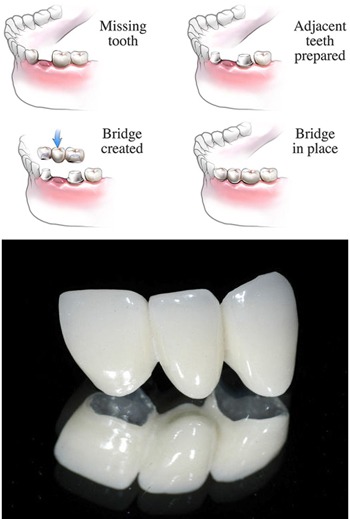Solutions for damaged and missing teeth.
A crown is a tooth-shaped cover placed over a tooth that is badly damaged or decayed. Many people call it a cap.
Crowns may be placed for several reasons. Usually the tooth has been broken or severely damaged by decay. As a result, a filling can’t replace enough of the tooth or make the tooth strong enough. A crown may hold together parts of a cracked tooth. Crowns can be used to improve appearance as well. They may be placed to cover misshapen or badly discolored teeth.
Crowns can be made of:

PFM and all-ceramic crowns are the same color as your natural teeth. They look just like normal teeth.
If you need a crown, you may also need endodontic or root canal treatment on the tooth. Not everyone who needs a crown will also need a root canal. Root canal treatment is required if the cavity is deep and reaches the pulp of the tooth, where the nerve of the tooth is located. Before placing a crown, if not much of the tooth is remaining, your dentist may need to build up a foundation to support it. A foundation is needed if large areas of the tooth are decayed, damaged or missing. Your dentist will also take an impression or Scan teeth above or below the tooth that will receive the crown. The purpose is to make sure the crown will fit into your normal bite. The impressions are sent to the lab, where the crown is made or made in House in CEREC CAD CAM machine. During that time, you will have a temporary crown placed. These crowns are usually made of plastic. These crowns are not meant to last for a long time. In some cases, however, a temporary crown can stay in place for few months. At a second visit, your dentist will remove the temporary crown and test the permanent one. Sometimes crowns need more polishing or glazing or some other adjustment before they are placed. Once the crown is ready, it is permanently cemented on your tooth.

Sometimes minor sensitivity or discomfort is normal after a crown is placed. If your tooth has not had a root canal treatment, it will still contain the nerve. You may therefore have some temporary sensitivity to cold. If you notice pain or sensitivity when you bite down, contact your dentist. Usually this means that the crown is a little high. When you bite, you are hitting the crown first. The crown needs to be adjusted. This can be done easily.
You may notice a thin, dark line next to the gumline on your crowned tooth if you look very closely in the mirror, particularly if you have a PFM crown. This dark line is the metal of the crown showing through. This is not a concern unless it appears on your front teeth and is visible. An all-porcelain crown, with no metal base, may be required to replace this crown.
A crowned tooth is protected from decay, except for the gum line. Your dentist may prescribe a high-fluoride gel for you to use every night if you have a high risk of developing cavities. A crown does not protect against gum disease. You should continue to brush twice a day and floss daily.
A bridge, also known as a fixed removable denture, is made to replace one or more missing teeth. A bridge consists of false teeth rigidly attached between two crowns. The teeth on either side of the gap are prepared for these crowns and the bridge is cemented into place. In some cases, it’s possible to use implants to replace the missing teeth rather than using the existing teeth. Once a bridge is cemented into position, it looks and works just like natural teeth
Getting a bridge requires at least two visits. At the first visit, your dentist prepares the teeth and covers them with temporary crowns. The dentist may also make impressions of the teeth.
When is a crown or bridge required?
Crowns and bridges are used to repair a number of different dental problems. A crown can be used when:

A bridge is used to replace a missing tooth or teeth. It is also a possible solution when dentures are unstable, uncomfortable or aesthetically displeasing.
To find out if you’re a suitable candidate for a crown or bridge, it’s essential that you are assessed by a dentist. Once you explain to your dentist the result you would like to achieve, they will be able to tell you exactly what is, and is not, possible in your situation.

It is very important to maintain exceptional oral hygiene. Brush and floss two to three times a day, taking extra care to floss around your crown. This will help avoid decay where the crown and the tooth join
Super floss or a dental floss threader can be used to clean under your bridge. There are also water jets on the market that will help keep your bridge clean.
Whether you have a crown or a bridge, the most important thing is to regularly visit your dentist for a checkup and clean. This way problems can be detected early, allowing them to be corrected timely.
- No Gap (For Private Dental Health Insurance Patients)
- Not With Health Fund, Just pay $179
Shop 3, Ground Floor, 101-107 Oxford
street, Bondi Junction NSW 2022
Phone: 02 9387 3181
Fax: +61 93877570
Email: bondi@dentallifeline.com.au
178 Mann street Gosford 2250.
Phone: 02 4323 7007
Fax: +61 4323 7009
Email: gosford@dentallifeline.com.au
Shop 3/135 Pacific Highway Hornsby
Phone: 02 9476 0070
Email: hornsby@dentallifeline.com.au
106 Victoria Street, East Maitland.
Opening Soon…
Copyright © 2024 Dental Lifeline | All Rights Reserved.